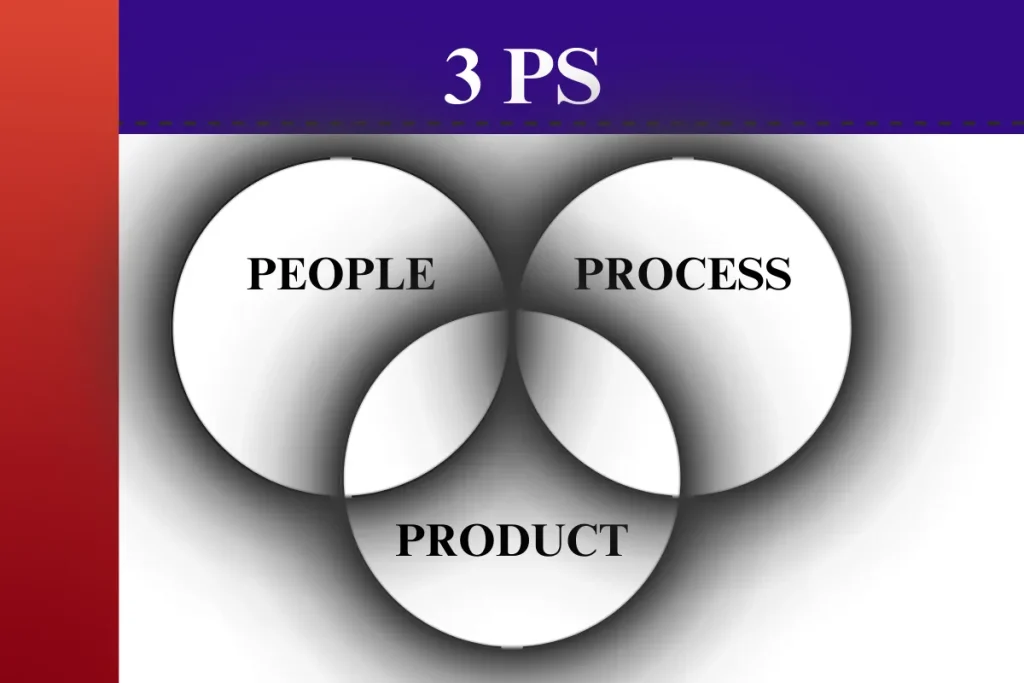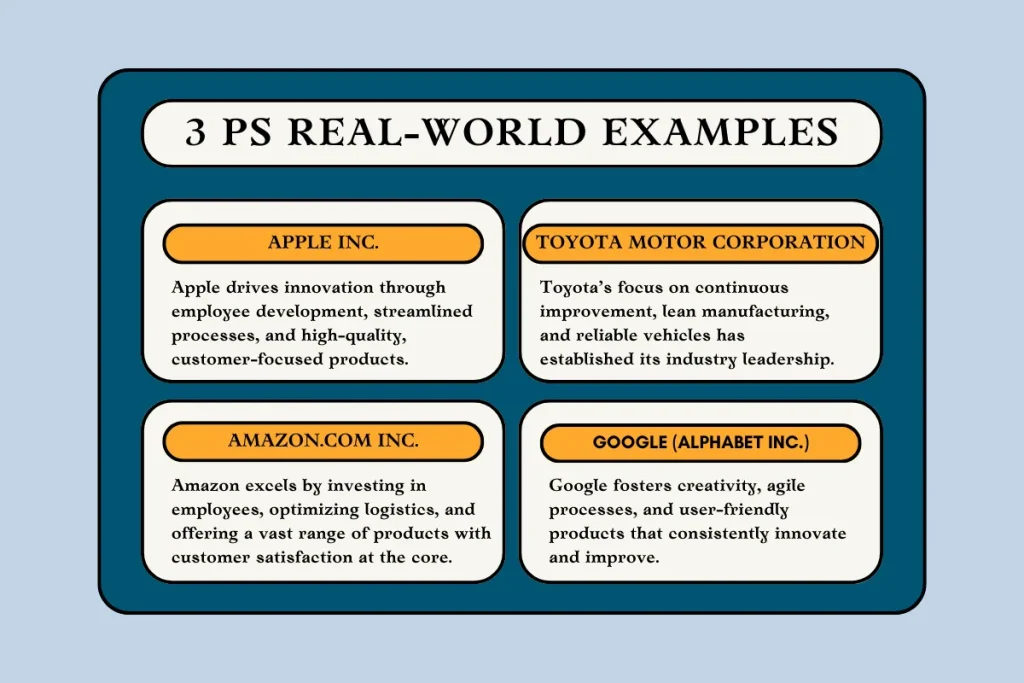Unlock Success with the 3Ps | People, Process, Product Explained
Feeling overwhelmed by the complexities of business management? Simplify it by focusing on the 3Ps: People, Process, and Product.
This guide explores how mastering these three elements leads to business success. Learning about the 3 Ps login can further streamline your business management efforts. Learn strategies to manage people effectively, streamline processes, and deliver exceptional products.
What Are the 3Ps?

Definition and Overview
The 3Ps stand for People, Process, and Product. They represent three fundamental pillars that are crucial for any business’s success.
Understanding and mastering these elements can help organizations streamline their operations, enhance performance, and achieve their goals.
Historical Context and Evolution
The concept of the three Ps has evolved. Initially, businesses focused primarily on products, ensuring they met customer needs. As markets became more competitive, the focus shifted to processes, aiming to optimize operations for better efficiency.
In recent years, the emphasis has expanded to people, recognizing that a skilled and motivated workforce is essential for sustainable success.
Importance in Modern Business Practices
In today’s dynamic business environment, the three p’s are more relevant than ever. Companies that excel in managing their people, optimizing their processes, and delivering high-quality products are more likely to thrive.
By integrating these elements, businesses can create a harmonious and efficient system that drives growth and innovation.
The 3Ps in Marketing

People in Marketing
Understanding your target audience is crucial for creating campaigns that resonate with them. Whether you’re engaging in B2B, B2C, or C2C (Consumer-to-Consumer) marketing, knowing who your customers are and what they want allows you to tailor your messaging effectively and build lasting relationships.
This involves segmenting your audience based on demographics, behavior, and preferences. By knowing who your customers are and what they want, you can tailor your messaging to meet their needs and build lasting relationships.
Engaging with your audience through personalized communication and addressing their pain points can significantly boost your marketing efforts.
Process in Marketing
Marketing involves developing, implementing, and monitoring effective strategies to reach your audience. This includes conducting market research, setting clear objectives, and creating a detailed marketing plan.
It’s essential to monitor your campaigns continuously, analyzing performance metrics to identify areas for improvement. A well-defined process ensures that your marketing efforts are organized, efficient, and aligned with your business goals.
Implement effective strategies, such as channel marketing, to reach your target audience and build lasting relationships.
Product in Marketing
In marketing, the product is not just about what you sell but how you present it to your audience. Creating products that meet customer needs and stand out in the market is vital. This involves product design, positioning, and branding.
By highlighting the unique features and benefits of your products, you can attract and retain customers. Additionally, gathering feedback from customers can help you improve your products and stay ahead of the competition.
The 3Ps in Business Management

People: The Core Asset
People are the backbone of any organization. A diverse and skilled workforce can drive innovation and growth. Fostering a culture of inclusion and continuous learning ensures that employees feel valued and motivated.
Effective leadership is also crucial for guiding teams toward achieving business goals. Leaders should focus on building strong team dynamics and promoting open communication.
Encouraging collaboration and recognizing individual contributions can significantly enhance overall performance.
Process: The Blueprint for Success
Streamlining business processes is essential for efficiency and productivity. Businesses need to develop clear and well-defined processes that are adaptable to change.
This includes mapping out workflows, identifying bottlenecks, and implementing solutions to improve efficiency. Risk management is also a critical aspect of process management.
By identifying potential risks and developing mitigation strategies, businesses can ensure smooth operations. Adapting to new technologies and innovative practices can further enhance process efficiency.
Product: Delivering Value
Delivering high-quality products that meet market needs is crucial for business success. Conducting thorough market research helps in understanding customer preferences and identifying market gaps.
Ensuring that products are of high quality and aligned with customer expectations can lead to increased customer satisfaction and loyalty. Innovation plays a significant role in product development.
Businesses should continuously seek ways to improve their products and stay ahead of the competition. Additionally, gathering and acting on customer feedback can lead to better products and services.
Exploring product management books can provide valuable insights and strategies for delivering high-quality products. Delivering high-quality products and focusing on high ticket sales can significantly boost business growth and customer satisfaction.
The 3Ps in Performance Management

Purpose: Driving Performance
Purpose is the foundation of effective performance management. It involves setting clear goals and objectives that align with the organization’s vision and mission.
When employees understand the purpose behind their work, they are more motivated and engaged. Defining individual and team goals that contribute to the overall business objectives is essential.
This alignment ensures that everyone is working towards a common goal, leading to improved performance and productivity.
People: Enhancing Employee Performance
People are at the heart of performance management. Investing in employee training and development is crucial for enhancing skills and competencies.
Regular feedback and appraisal sessions help in identifying areas for improvement and recognizing achievements. Encouraging a culture of continuous learning and growth can lead to higher employee satisfaction and retention.
Effective communication and collaboration within teams also play a significant role in driving performance. By providing the necessary support and resources, organizations can empower their employees to excel.
Process: Monitoring and Improvement
Processes are essential for monitoring and improving performance. Implementing performance metrics and key performance indicators (KPIs) helps in tracking progress and identifying areas for improvement.
Continuous monitoring ensures that any issues are addressed promptly, and corrective actions are taken. Adapting processes based on feedback and performance data is crucial for continuous improvement.
By fostering a culture of accountability and transparency, organizations can create an environment where performance is consistently monitored and enhanced. Implementing product management frameworks can support effective process monitoring and continuous improvement.
The 3Ps in Project Management

People: The Human Element
People are the driving force behind any successful project. Effective project management begins with strong leadership and teamwork.
Leaders should focus on building collaborative teams where each member’s skills and strengths are utilized. Clear communication is vital for ensuring that everyone is on the same page and working towards common goals.
Stakeholder engagement is also crucial; involving stakeholders in the planning and decision-making process can lead to better outcomes and higher satisfaction.
Regular feedback and recognition can motivate team members and foster a positive work environment.
Process: The Roadmap to Success
A well-defined process is essential for the success of any project. This involves careful planning, execution, and monitoring. During the planning phase, it’s important to outline the project’s scope, objectives, and deliverables.
Execution involves coordinating resources, managing timelines, and ensuring that tasks are completed efficiently. Monitoring and controlling are ongoing activities that help identify and address any deviations from the plan.
Risk management is a critical component, as it involves identifying potential risks and developing strategies to mitigate them. Change management is also important for adapting to any changes that may arise during the project’s lifecycle.
Product: The End Goal
The ultimate goal of project management is to deliver a product that meets or exceeds expectations. This requires a clear understanding of the project’s requirements and objectives.
Quality assurance plays a significant role in ensuring that the final product meets the desired standards. Regular testing and validation throughout the project lifecycle can help identify and address any issues early on.
Customer focus is also essential; understanding and addressing customer needs and feedback can lead to a more successful product.
Timely delivery and deployment are crucial for meeting project deadlines and ensuring customer satisfaction.
Integrating the 3Ps Across Business Functions
How People Drive Processes and Products
People are the foundation of any business function. Skilled and motivated employees are essential for driving efficient processes and creating high-quality products.
By investing in employee training and development, businesses can enhance their workforce’s capabilities, leading to improved performance and innovation.
Fostering a culture of collaboration and open communication ensures that employees can contribute their best ideas and efforts to the organization’s success.
How Processes Support People and Products
Effective processes are designed to support and enhance the work of people and the quality of products. Streamlining workflows, implementing best practices, and leveraging technology can significantly improve efficiency and productivity.
Processes should be continuously monitored and optimized to adapt to changing business needs and market conditions.
By creating a well-defined and adaptable process framework, businesses can ensure that their employees have the tools and resources they need to succeed.
The Ultimate Goal: Successful Products
The primary objective of integrating the 3p is to deliver successful products that meet customer needs and drive business growth.
This involves aligning product development with the capabilities of the workforce and the efficiency of the processes. By focusing on customer feedback and market research, businesses can create products that stand out in the market.
Continuous improvement and innovation are key to maintaining a competitive edge and ensuring long-term success. Aligning product development with B2C Business to Consumer commerce principles ensures that products meet customer needs and drive business growth.
Practical Tips for Managing the Three Ps

Tips on Managing People
- Build a positive work environment: Ensure employees feel valued and motivated.
- Implement regular training and development programs: Enhance employee skills and competencies.
- Encourage open communication: Foster an environment where feedback is welcomed and acted upon.
- Recognize and reward outstanding performance: Boost morale and motivate employees.
- Prioritize diversity and inclusion: Embrace different perspectives and ideas to drive innovation.
Tips on Optimizing Processes
- Map out existing processes: Identify bottlenecks and inefficiencies.
- Use technology and automation tools: Simplify repetitive tasks and improve efficiency.
- Implement best practices: Ensure processes are effective and aligned with business goals.
- Continuously monitor and review processes: Adapt to changing business needs and market conditions.
- Involve employees in process improvement: Gather valuable insights and suggestions from the workforce.
Tips on Enhancing Product Value
- Conduct thorough market research: Understand customer needs and preferences.
- Focus on quality assurance: Ensure products meet or exceed customer expectations.
- Encourage innovation: Foster a culture of creativity and experimentation.
- Gather and act on customer feedback: Continuously improve products based on feedback.
- Market products effectively: Highlight unique features and benefits to stand out in the competitive market.
Case Studies and Real-World Examples

Successful Companies Implementing the 3Ps
1. Apple Inc.:
- People: Apple invests heavily in employee development and maintains a culture of innovation. The company encourages collaboration and values diverse perspectives.
- Process: Apple’s processes are streamlined to ensure efficiency and quality. They use advanced technology and automation to optimize production.
- Product: Apple focuses on creating high-quality, innovative products that meet customer needs. Their commitment to design and functionality has made them a market leader.
2. Toyota Motor Corporation:
- People: Toyota emphasizes employee training and development, fostering a culture of continuous improvement (Kaizen).
- Process: Toyota’s production system is a benchmark in the industry. Their lean manufacturing processes reduce waste and improve efficiency.
- Product: Toyota produces reliable, high-quality vehicles. Their focus on innovation and customer satisfaction has earned them a loyal customer base.
3. Amazon.com Inc.:
- People: Amazon invests in its employees through training programs and career development opportunities. They prioritize employee feedback and foster a customer-centric culture.
- Process: Amazon’s logistics and supply chain processes are optimized for speed and efficiency. They use data analytics to continuously improve operations.
- Product: Amazon offers a wide range of products, focusing on customer convenience and satisfaction. Their commitment to fast delivery and competitive pricing sets them apart.
4. Starbucks Success Through the 3Ps in 2025
- People: Starbucks invests in employee training and fostering a positive work culture, ensuring motivated staff who deliver exceptional customer service.
- Process: The company streamlines operations with technology, like mobile ordering, to improve efficiency and enhance the customer experience.
- Product: Starbucks continuously innovates, offering high-quality coffee and food options that meet diverse customer needs, including plant-based alternatives.
Lessons Learned from Industry Leaders
- Invest in People:
- Companies that prioritize employee development and well-being see higher engagement and productivity.
- A diverse and inclusive workforce brings innovative ideas and solutions to the table.
- Optimize Processes:
- Streamlining workflows and using technology can significantly improve efficiency and reduce costs.
- Continuous monitoring and improvement of processes ensure adaptability to changing market conditions.
- Focus on Product Quality:
- High-quality products that meet customer needs drive satisfaction and loyalty.
- Innovation in product development is essential for maintaining a competitive edge.
Key Takeaways
Summary of Essential Points
- People: The backbone of any business. Investing in employee development and fostering a positive work environment leads to higher engagement and productivity.
- Process: The blueprint for success. Streamlining workflows, adopting best practices, and leveraging technology ensure efficiency and adaptability.
- Product: The ultimate goal. Delivering high-quality products that meet customer needs drives satisfaction, loyalty, and business growth.
The Impact of the 3Ps on Business Success
- Enhanced Performance: Integrating the three Ps leads to improved overall performance and competitiveness.
- Innovation and Growth: Encouraging innovation in people, processes, and products fosters business growth and sustainability.
- Customer Satisfaction: Focusing on quality and customer needs ensures higher satisfaction and loyalty.
Summary Table
|
Aspect |
Key Points |
Impact on Business |
|
People |
Employee development, positive work environment, engagement, productivity |
Enhanced performance, innovation |
|
Process |
Streamlined workflows, best practices, technology adoption |
Efficiency, adaptability, improved competitiveness |
|
Product |
High-quality products, customer needs, satisfaction, loyalty |
Business growth, customer satisfaction, innovation |
Conclusion
Mastering the 3Ps—People, Process, and Product—is crucial for driving business success. This approach helps streamline operations and foster growth.
Focus on continuous improvement and innovation to stay ahead. Use the three Ps to boost performance and achieve your business goals. For insights on effective business practices, check out Harvard Business Review.
FAQs
What are the 3 P’s of process?
The 3 P's of process refer to "People, Process, and Product," focusing on optimizing each element to improve efficiency and effectiveness.
What are the 3 P’s of strategy?
The 3 P's of strategy are "People, Process, and Product," which help in forming a comprehensive strategic approach for achieving business objectives.






